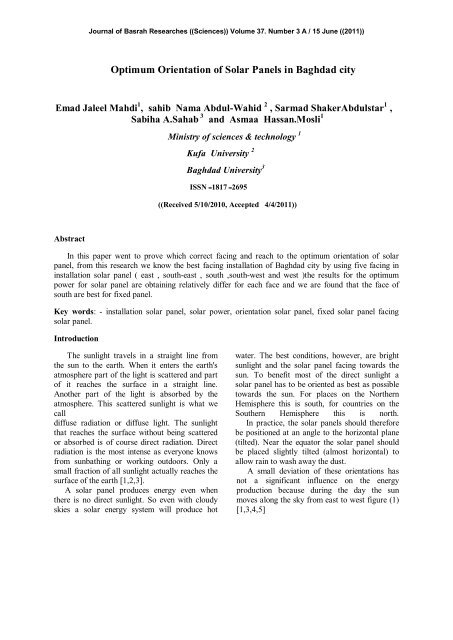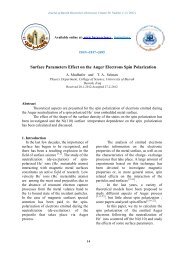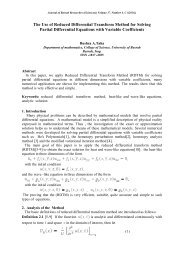Optimum Orientation of Solar Panels in ... - Basra-science-journal.org
Optimum Orientation of Solar Panels in ... - Basra-science-journal.org
Optimum Orientation of Solar Panels in ... - Basra-science-journal.org
You also want an ePaper? Increase the reach of your titles
YUMPU automatically turns print PDFs into web optimized ePapers that Google loves.
Journal <strong>of</strong> <strong>Basra</strong>h Researches ((Sciences)) Volume 37. Number 3 A / 15 June ((2011))<br />
<strong>Optimum</strong> <strong>Orientation</strong> <strong>of</strong> <strong>Solar</strong> <strong>Panels</strong> <strong>in</strong> Baghdad city<br />
Emad Jaleel Mahdi 1 , sahib Nama Abdul-Wahid 2 , Sarmad ShakerAbdulstar 1 ,<br />
Sabiha A.Sahab 3 and Asmaa Hassan.Mosli 1<br />
Abstract<br />
M<strong>in</strong>istry <strong>of</strong> <strong>science</strong>s & technology 1<br />
Kufa University 2<br />
Baghdad University 3<br />
ISSN���1817���2695<br />
((Received 5/10/2010, Accepted 4/4/2011))<br />
In this paper went to prove which correct fac<strong>in</strong>g and reach to the optimum orientation <strong>of</strong> solar<br />
panel, from this research we know the best fac<strong>in</strong>g <strong>in</strong>stallation <strong>of</strong> Baghdad city by us<strong>in</strong>g five fac<strong>in</strong>g <strong>in</strong><br />
<strong>in</strong>stallation solar panel ( east , south-east , south ,south-west and west )the results for the optimum<br />
power for solar panel are obta<strong>in</strong><strong>in</strong>g relatively differ for each face and we are found that the face <strong>of</strong><br />
south are best for fixed panel.<br />
Key words: - <strong>in</strong>stallation solar panel, solar power, orientation solar panel, fixed solar panel fac<strong>in</strong>g<br />
solar panel.<br />
Introduction<br />
The sunlight travels <strong>in</strong> a straight l<strong>in</strong>e from<br />
the sun to the earth. When it enters the earth's<br />
atmosphere part <strong>of</strong> the light is scattered and part<br />
<strong>of</strong> it reaches the surface <strong>in</strong> a straight l<strong>in</strong>e.<br />
Another part <strong>of</strong> the light is absorbed by the<br />
atmosphere. This scattered sunlight is what we<br />
call<br />
diffuse radiation or diffuse light. The sunlight<br />
that reaches the surface without be<strong>in</strong>g scattered<br />
or absorbed is <strong>of</strong> course direct radiation. Direct<br />
radiation is the most <strong>in</strong>tense as everyone knows<br />
from sunbath<strong>in</strong>g or work<strong>in</strong>g outdoors. Only a<br />
small fraction <strong>of</strong> all sunlight actually reaches the<br />
surface <strong>of</strong> the earth [1,2,3].<br />
A solar panel produces energy even when<br />
there is no direct sunlight. So even with cloudy<br />
skies a solar energy system will produce hot<br />
water. The best conditions, however, are bright<br />
sunlight and the solar panel fac<strong>in</strong>g towards the<br />
sun. To benefit most <strong>of</strong> the direct sunlight a<br />
solar panel has to be oriented as best as possible<br />
towards the sun. For places on the Northern<br />
Hemisphere this is south, for countries on the<br />
Southern Hemisphere this is north.<br />
In practice, the solar panels should therefore<br />
be positioned at an angle to the horizontal plane<br />
(tilted). Near the equator the solar panel should<br />
be placed slightly tilted (almost horizontal) to<br />
allow ra<strong>in</strong> to wash away the dust.<br />
A small deviation <strong>of</strong> these orientations has<br />
not a significant <strong>in</strong>fluence on the energy<br />
production because dur<strong>in</strong>g the day the sun<br />
moves along the sky from east to west figure (1)<br />
[1,3,4,5]
<strong>Solar</strong> cells have been receiv<strong>in</strong>g a great deal <strong>of</strong><br />
attention <strong>in</strong> recent years as one source <strong>of</strong><br />
renewable, environmentally-friendly energy.<br />
One problem with solar cells, however, is the<br />
fact that the amount <strong>of</strong> power that can be<br />
generated is unstable, because the quantity <strong>of</strong><br />
sunlight hitt<strong>in</strong>g the solar cell panel surface is<br />
affected by weather and other factors. In order to<br />
maximize power generation efficiency, it is<br />
When <strong>in</strong>stall<strong>in</strong>g photovoltaic modules, be aware<br />
that they generate maximum power when fac<strong>in</strong>g<br />
the sun directly. The fixed position which<br />
approximates this ideal over the course <strong>of</strong> the<br />
year, thus maximiz<strong>in</strong>g annual energy<br />
production, is fac<strong>in</strong>g due South (<strong>in</strong> the Northern<br />
Hemisphere) or due North (<strong>in</strong> the Southern<br />
Hemisphere) at the angle listed <strong>in</strong> the table <strong>in</strong><br />
the next column. Note that these orientations are<br />
true<br />
The mount<strong>in</strong>g configuration <strong>of</strong> a PV module<br />
depends on whether it is mono facial <strong>of</strong> bifacial<br />
or on its application. Conventional modules are<br />
normally mounted fac<strong>in</strong>g the equator with the<br />
Mahdi Abdul-Wahid , Abdulstar , Sahab & Mosli<br />
Fig (1) shows the sun mov<strong>in</strong>g<br />
Fig (2) shows fixed solar panel<br />
1<br />
necessary to design a system that is able to<br />
change the orientation <strong>of</strong> the solar cell panel to<br />
suit changes <strong>in</strong> the angle <strong>of</strong> the sun due to the<br />
rotation and revolution <strong>of</strong> the Earth, and<br />
seasonal changes. In spite <strong>of</strong> the above, most<br />
solar cell panels are po<strong>in</strong>ted <strong>in</strong> a fixed direction<br />
figure (2), because it costs too much to be<br />
cont<strong>in</strong>ually chang<strong>in</strong>g their orientation [3, 4, 5,<br />
6].<br />
tilt equal to the latitude angle. However, for<br />
some applications a different mount<strong>in</strong>g<br />
configuration may be optimum [2, 6, 7, 8].<br />
At some <strong>in</strong>stallations, it may be costeffective<br />
to adjust the tilt seasonally. At most<br />
latitudes, performance can be improved dur<strong>in</strong>g<br />
the summer by us<strong>in</strong>g an angle flatter than the<br />
chart’s recommendation; conversely, a steeper<br />
angle can improve w<strong>in</strong>ter performance. In<br />
design<strong>in</strong>g the optimal tilt angle and orientation<br />
<strong>of</strong> a fixed solar panel for maximiz<strong>in</strong>g its energy<br />
collection is to acquire the maximum solar<br />
radiation availability at the required location, a<br />
number <strong>of</strong> studies have been conducted by
various researchers to determ<strong>in</strong>e the optimum<br />
location for solar radiation collection us<strong>in</strong>g<br />
different empirical models. However, solar<br />
radiation varies with geographic latitude, season,<br />
and time <strong>of</strong> a day due to the various sun<br />
positions under the unpredictable weather<br />
conditions. Systematic long-term data<br />
measurements are regarded as the most effective<br />
and accurate method <strong>of</strong> sett<strong>in</strong>g up the solar<br />
radiation database. In many parts <strong>of</strong> the world,<br />
the basic solar data for the surfaces <strong>of</strong> <strong>in</strong>terest<br />
are not always readily obta<strong>in</strong>able. It is also<br />
impracticable to measure the solar radiation for<br />
every tilt angle to deduce the peak value.<br />
Traditionally, solar radiation on an <strong>in</strong>cl<strong>in</strong>ed<br />
surface is model led us<strong>in</strong>g horizontal data.<br />
If modules are not cleaned regularly, it is<br />
recommended that they not be mounted at an<br />
angle flatter than 15”. Flatter angles cannot take<br />
ful1 advantage <strong>of</strong> the clean<strong>in</strong>g action <strong>of</strong> ra<strong>in</strong>fall<br />
[2,3,6,7,8]<br />
To capture the maximum amount <strong>of</strong> solar<br />
radiation over a year, the solar array should be<br />
tilted at an angle approximately equal to a site's<br />
latitude, and fac<strong>in</strong>g with<strong>in</strong> 15° <strong>of</strong> due south. To<br />
optimize w<strong>in</strong>ter performance, the solar array can<br />
be tilted 15° more than the latitude angle, and to<br />
optimize summer performance, 15° less than the<br />
latitude angle. At any given <strong>in</strong>stant, the array<br />
Magnetic decl<strong>in</strong>ation, the angle difference<br />
between magnetic south and true solar south,<br />
must also be taken <strong>in</strong>to account when<br />
determ<strong>in</strong><strong>in</strong>g proper solar array orientation. If a<br />
magnetic compass alone is used to determ<strong>in</strong>e<br />
where to po<strong>in</strong>t the array, you may not capture<br />
<strong>Optimum</strong> <strong>Orientation</strong> <strong>of</strong> <strong>Solar</strong> <strong>Panels</strong> <strong>in</strong> Baghdad …<br />
Fig (3) shows fac<strong>in</strong>g south and sun path [3]<br />
2<br />
will output maximum available power when<br />
po<strong>in</strong>ted directly at the sun<br />
To compare the energy output <strong>of</strong> your<br />
array to the optimum value, you will need to<br />
know the site's latitude, and the actual tilt angle<br />
<strong>of</strong> your array-which may be the slope <strong>of</strong> your<br />
ro<strong>of</strong> if your array is flush-mounted. If your solar<br />
array tilt is with<strong>in</strong> 15° <strong>of</strong> the latitude angle, you<br />
can expect a reduction <strong>of</strong> 5% or less <strong>in</strong> your<br />
system's annual energy production. If your solar<br />
array tilt is greater than 15° <strong>of</strong>f the latitude<br />
angle, the reduction <strong>in</strong> your system's annual<br />
energy production may fall by as much as 15%<br />
from its peak available value. Dur<strong>in</strong>g w<strong>in</strong>ter<br />
months at higher latitudes, the reduction will be<br />
greater.<br />
If a south-fac<strong>in</strong>g ro<strong>of</strong> is unavailable, or<br />
the total solar array is larger than the area <strong>of</strong> a<br />
south-fac<strong>in</strong>g ro<strong>of</strong> section, an east or west-fac<strong>in</strong>g<br />
surface is the next best option figure (3). Be<br />
aware that solar power output decreases<br />
proportionally with a horizontal angle, or<br />
"azimuth," greater than 15° from due south. The<br />
decrease <strong>in</strong> annual power output from a latitudetilted<br />
east or west-fac<strong>in</strong>g array may be as much<br />
as 15% or more <strong>in</strong> the lower latitudes or as<br />
much as 25% or more <strong>in</strong> the higher latitudes <strong>of</strong><br />
the United States. Avoid direct<strong>in</strong>g your tilted<br />
solar panels northwest, north or northeast, as<br />
you'll get little power output.<br />
the maximum amount <strong>of</strong> solar radiation<br />
[3,6,8,9].<br />
The momentary output <strong>of</strong> your system depends<br />
on the angle <strong>of</strong> the sun and the clearness <strong>of</strong> the<br />
sky as well as the temperature and the<br />
cleanl<strong>in</strong>ess <strong>of</strong> the solar module glass. An
idealized “typical” pr<strong>of</strong>ile <strong>of</strong> system output<br />
dur<strong>in</strong>g a day is shown. In the early morn<strong>in</strong>g,<br />
even though the day is “bright” to the eye, the<br />
angle <strong>of</strong> the sun to the solar modules is very low<br />
result<strong>in</strong>g <strong>in</strong> a reduced power output. As the sun<br />
rises <strong>in</strong> the sky, it moves more directly <strong>in</strong> front<br />
<strong>of</strong> the modules and the output rises to a peak<br />
value near noon. As the sun beg<strong>in</strong>s its decent,<br />
the angle <strong>of</strong> the sun to the panels gets lower and<br />
reduces the power output <strong>of</strong> the system. Some<br />
actual daily pr<strong>of</strong>iles are shown here to illustrate<br />
the effects <strong>of</strong> sky conditions on output. Notice<br />
how the real pr<strong>of</strong>iles vary moment to moment<br />
compared to the smooth idealized pr<strong>of</strong>ile . This<br />
is a more true representation <strong>of</strong> how your system<br />
output will vary dur<strong>in</strong>g a day.<br />
1- Procedure:-<br />
1-1- Equipments experimental <strong>in</strong>cluded:-<br />
Restriction the orientations fac<strong>in</strong>g for<br />
<strong>in</strong>stallation panels <strong>in</strong> five directions to recognize<br />
optimum orientation like ( east , south-east ,<br />
2-1 - We amounted the (5) solar panels <strong>in</strong> tilt<br />
angle 35 degree to reach more amount <strong>of</strong> solar<br />
radiation on solar panel surface as w<strong>in</strong>ter tilt<br />
angle and <strong>in</strong> a sunny area the solar panel that<br />
<strong>Optimum</strong> <strong>Orientation</strong> <strong>of</strong> <strong>Solar</strong> <strong>Panels</strong> <strong>in</strong> Baghdad …<br />
Fig ( 4 ) shows the five orientation fac<strong>in</strong>g<br />
2<br />
If the build<strong>in</strong>g orientation is east to west about<br />
80 percent <strong>of</strong> the solar energy is available to the<br />
panels. In both situations, the assumption is<br />
made that panels have the correct tilt and no<br />
shad<strong>in</strong>g,<br />
If the ro<strong>of</strong> orientation doesn’t allow for a<br />
southern exposure or aesthetics many solar<br />
panel’s placed on a ground rack at the ideal tilt<br />
Seasonal changes <strong>in</strong> Sun’s angle along with<br />
shortened daylight, and weather also affect<br />
annual sun hours or solar isolation. <strong>Solar</strong><br />
<strong>in</strong>sulation refers to the amount <strong>of</strong> solar energy,<br />
direct or diffuse, reach<strong>in</strong>g the earth per a unit <strong>of</strong><br />
time [2,7,9]<br />
south ,south-west and west ).Shown <strong>in</strong> figure<br />
(4).<br />
properties 80 watt open circuit17 V short circuit<br />
5.4 Amp mono crystall<strong>in</strong>e type shown <strong>in</strong> figure<br />
( 5)
Mahdi Abdul-Wahid , Abdulstar , Sahab & Mosli<br />
Fig ( 5 ) shows the five solar panels <strong>in</strong>stallation <strong>in</strong> five direction<br />
3-1- We read solar radiation form weather<br />
station with Data logger to read solar radiation<br />
<strong>in</strong> (w/m 2 ) watch dog type, this read<strong>in</strong>g with time<br />
to long day hours to know how much can solar<br />
panel produce the energy follow to <strong>in</strong>cident<br />
solar radiation.<br />
Results and Discussion :-<br />
We measure the solar radiation from the<br />
weather station at every quarter hour to long day<br />
and beg<strong>in</strong>n<strong>in</strong>g the measure from the 8 A.m. to 2<br />
p.m. Figure (6) shows the solar radiation with<br />
time <strong>in</strong> 6/4/2010 , to camper between the<br />
amount <strong>of</strong> solar radiation accident on fac<strong>in</strong>g<br />
orientation solar panel , and the amount <strong>of</strong> solar<br />
radiation beg<strong>in</strong>s <strong>in</strong> sunrise a small amount,<br />
Fig (6) shows the solar radiation with time<br />
1<br />
4-1- Multimeter for measure the current <strong>in</strong><br />
short circuit state for five solar panels 80 watt<br />
with time to long day hours to five panels (<strong>in</strong><br />
sunny day )<br />
because the air mass be bigger amount and it is<br />
dependent on cos� this causes attenuation for<br />
solar radiation and reach to peak power <strong>of</strong> solar<br />
radiation <strong>in</strong> midday the cos� closer to 1 about<br />
11.45 A.m. because the angle between sun and<br />
solar panel surface changes for long day and<br />
solar radiation accident on solar panel is<br />
different <strong>in</strong> every angle.
Journal <strong>of</strong> <strong>Basra</strong>h Researches ((Sciences)) Volume 37. Number 3 A / 15 June ((2011))<br />
We read the current for 5 panels by us<strong>in</strong>g<br />
multimeter <strong>in</strong> short circuit state with the time <strong>in</strong><br />
every quarter hour to long day from the 8 A.m.<br />
to 2 p.m. this read<strong>in</strong>g shown <strong>in</strong> figure (7) <strong>in</strong><br />
sunny day the output for solar panel different <strong>in</strong><br />
Conclusions:-<br />
every angle sun position the output solar panel<br />
dependent on solar radiation amount and the<br />
peak output solar panel be when the sun position<br />
perpendicular on solar panel surface.<br />
Fig (7) shows the output solar panels (current) with the time<br />
From these result we have noticed that the<br />
output to the solar panel change for all solar<br />
panels are dependent on the amount <strong>of</strong> solar<br />
radiation because difference the fac<strong>in</strong>g between<br />
the sun and solar panel surface the panel on the<br />
east fac<strong>in</strong>g be low power output because the<br />
solar radiation be low dependent on air mass<br />
amount and the panels output fac<strong>in</strong>g to south -<br />
west , west be like to east panel because not be<br />
fac<strong>in</strong>g to sun <strong>in</strong> the mourn<strong>in</strong>g , the best fac<strong>in</strong>g<br />
orientation panel be <strong>in</strong> three fac<strong>in</strong>gs (south ,<br />
south - east and south - west) the peak output<br />
power solar panel be <strong>in</strong> south fac<strong>in</strong>g orientation<br />
because the sun path be proportionally<br />
perpendicular to solar panel to anther solar<br />
panels , from this curve there is some dip<br />
because there is some <strong>of</strong> pieces clouds <strong>in</strong><br />
atmosphere causes attenuation solar rays.
Journal <strong>of</strong> <strong>Basra</strong>h Researches ((Sciences)) Volume 37. Number 3 A / 15 June ((2011))<br />
References:-<br />
1- A.W. Blakers, P.N.K. Deenapanray, L.A.<br />
Sadkowsky, V. Everett and J. Babaei (The<br />
effect <strong>of</strong> bifacial sliver module orientation<br />
on energy production) , K.J. Weber, Centre<br />
for Susta<strong>in</strong>able Energy Systems The<br />
Australian National University, Canberra<br />
ACT 0200, Australia-2002<br />
2- A. A, Hanieh (Automatic <strong>Orientation</strong> <strong>of</strong><br />
<strong>Solar</strong> Photovoltaic <strong>Panels</strong>)- Mechanical<br />
Eng<strong>in</strong>eer<strong>in</strong>g Department, Birzeit University<br />
,Birzeit, Palest<strong>in</strong>e- GCREEDER 2009,<br />
Amman-Jordan, March 31st – April 2nd<br />
2009<br />
3- D. H.,W. Li. and T. N., T. Lam.<br />
(Determ<strong>in</strong><strong>in</strong>g the <strong>Optimum</strong> Tilt Angle and<br />
<strong>Orientation</strong> for <strong>Solar</strong> Energy Collection<br />
Based on Measured <strong>Solar</strong> Radiance Data)- ;<br />
H<strong>in</strong>dawi Publish<strong>in</strong>g Corporation-<br />
International Journal <strong>of</strong> Photoenergy-Volume<br />
2007, Article ID 85402, 9 pages<br />
doi:10.1155/2007/85402<br />
4- C.M., Chiang.C., Y.Lee., W. J. Hwng. and<br />
P. C. Chou. (<strong>Solar</strong> <strong>Orientation</strong> Measurement<br />
3<br />
1<br />
������������������ � ���������������������<br />
3<br />
�����������<br />
Systems with Integrated <strong>Solar</strong> Cells) ,<br />
Taiwan-, 2008, 2, 280-286.<br />
5- M. K. , Simsek., Y. B. Sedat.( Determ<strong>in</strong><strong>in</strong>g<br />
optimum tilt angles and orientations <strong>of</strong><br />
photovoltaic panels <strong>in</strong> Sanliurfa), , Harran<br />
University, Sanliurfa, Turkey. - 19 February<br />
2004.<br />
6- B. Bruns. (<strong>Solar</strong> Panel Optimizer - Project<br />
description Woods Residence)--May 29,<br />
2008<br />
7- Owner’s Manual- GE Energy (<strong>Solar</strong> Electric<br />
Power System)- - USA- T 302.451.7400- F<br />
302.451.7501.<br />
8- V.H. Morcos (<strong>Optimum</strong> tilt angle and<br />
orientation for solar collectors <strong>in</strong> Assiut), -<br />
Mechanical Eng<strong>in</strong>eer<strong>in</strong>g Department, Assiut<br />
9-<br />
����������������������������������<br />
2<br />
1<br />
���������������<br />
2<br />
� ������������/<br />
������������ �<br />
�<br />
University, Assiut, Egypt , 2 July 2003<br />
Tropical latitudes-Emanuele Calabrò<br />
(Determ<strong>in</strong><strong>in</strong>g optimum tilt angles <strong>of</strong><br />
photovoltaic panels at typical north)- -<br />
Department <strong>of</strong> Physics, University <strong>of</strong><br />
Mess<strong>in</strong>a, Mess<strong>in</strong>a 98122, Italy- 2009<br />
������ �������������<br />
1<br />
��������������������������<br />
�<br />
1<br />
��������������<br />
-:<br />
�������<br />
��������������������������������������������������������������������������������������������������������<br />
������������������������������)<br />
��������������������<br />
������������������������������������������������ ����<br />
. ( ����������������������<br />
������������������������������������������������������ ���������������������������������������������������<br />
. �������








